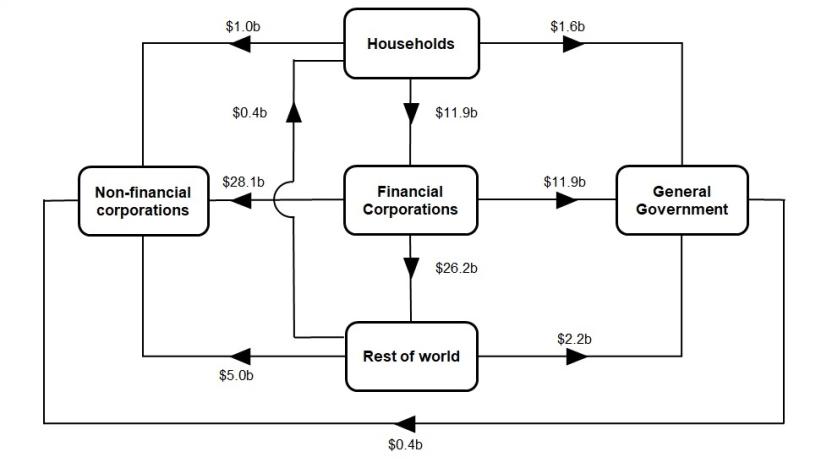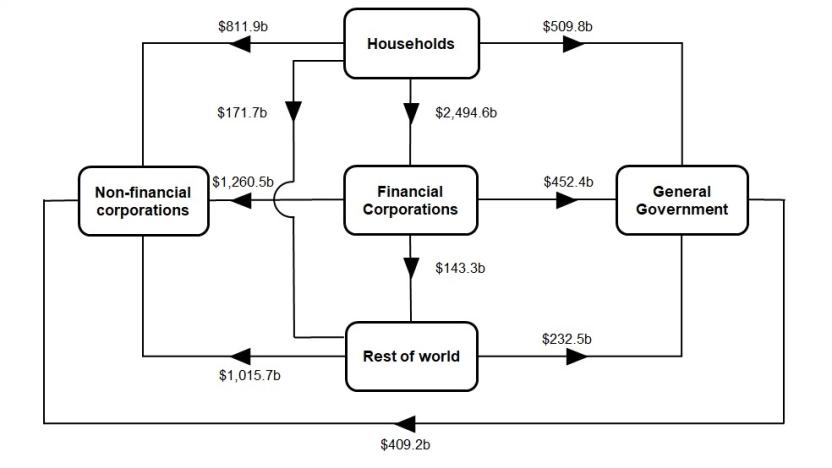Change in authorised deposit taking institutions' assets
[["Mar-09","Jun-09","Sep-09","Dec-09","Mar-10","Jun-10","Sep-10","Dec-10","Mar-11","Jun-11","Sep-11","Dec-11","Mar-12","Jun-12","Sep-12","Dec-12","Mar-13","Jun-13","Sep-13","Dec-13","Mar-14","Jun-14","Sep-14","Dec-14","Mar-15","Jun-15","Sep-15","Dec-15","Mar-16","Jun-16","Sep-16","Dec-16","Mar-17","Jun-17","Sep-17","Dec-17","Mar-18","Jun-18","Sep-18","Dec-18","Mar-19","Jun-19","Sep-19","Dec-19","Mar-20","Jun-20","Sep-20","Dec-20","Mar-21","Jun-21","Sep-21","Dec-21","Mar-22"],[[-2.5],[31.5],[31.399999999999999],[10.300000000000001],[18],[45.399999999999999],[30.199999999999999],[9.6999999999999993],[45.899999999999999],[32.299999999999997],[98.099999999999994],[-14.800000000000001],[13.4],[66],[37.399999999999999],[17.899999999999999],[28.699999999999999],[79.099999999999994],[18.399999999999999],[90],[21.199999999999999],[66.400000000000006],[89],[118],[149],[-1.1000000000000001],[139.19999999999999],[-12.4],[49.299999999999997],[76.400000000000006],[5.2999999999999998],[67.5],[-27.100000000000001],[56.299999999999997],[-19.100000000000001],[20.5],[80.900000000000006],[37.600000000000001],[-2],[52.600000000000001],[29.399999999999999],[78],[105.3],[-38.799999999999997],[467.60000000000002],[-161],[-66.200000000000003],[17.5],[-35.899999999999999],[22.5],[123],[121.5],[153.59999999999999]],[[-17.199999999999999],[7.5999999999999996],[-16.600000000000001],[-3.3999999999999999],[1],[4.5],[-7.2000000000000002],[8.0999999999999996],[5.9000000000000004],[-3.3999999999999999],[7.2000000000000002],[-18.800000000000001],[-5.7999999999999998],[-6.5],[2.1000000000000001],[-5.7000000000000002],[1.1000000000000001],[-4],[-2.2000000000000002],[17.899999999999999],[-0.10000000000000001],[0.80000000000000004],[1.7],[-3.5],[-1.1000000000000001],[-3.2000000000000002],[3.2999999999999998],[3.6000000000000001],[-0.20000000000000001],[-0.29999999999999999],[-0.69999999999999996],[1.1000000000000001],[3.3999999999999999],[0.59999999999999998],[-1.8999999999999999],[-1.8],[11],[-0.59999999999999998],[2.7000000000000002],[-0.5],[0.5],[1.7],[3.1000000000000001],[2.7000000000000002],[78.099999999999994],[-24.600000000000001],[-21.300000000000001],[48.299999999999997],[98.700000000000003],[133],[55.100000000000001],[34.200000000000003],[16.600000000000001]],[[-0.90000000000000002],[7.2999999999999998],[-3.5],[-1.3999999999999999],[-8.3000000000000007],[-8.4000000000000004],[1.8],[-3.3999999999999999],[-3.1000000000000001],[-0.90000000000000002],[0.20000000000000001],[-4.5],[5.4000000000000004],[1],[-0.80000000000000004],[-0.40000000000000002],[-8.3000000000000007],[-9.5999999999999996],[0.40000000000000002],[-7.7000000000000002],[-9.4000000000000004],[5.4000000000000004],[-4.2000000000000002],[3.8999999999999999],[0.5],[-6.5999999999999996],[2.2000000000000002],[-2.7000000000000002],[4.0999999999999996],[-13.9],[-6.7999999999999998],[2.1000000000000001],[-4.9000000000000004],[-4],[-0.40000000000000002],[-6.5],[3.2999999999999998],[0.40000000000000002],[-13.800000000000001],[5.5999999999999996],[-2.2000000000000002],[-5.0999999999999996],[-3.7999999999999998],[3.7000000000000002],[8.5],[8],[-16.199999999999999],[-1.1000000000000001],[-12.300000000000001],[-0.80000000000000004],[-9.9000000000000004],[9.5999999999999996],[5.7000000000000002]],[[30],[23],[3.2999999999999998],[13.5],[5.4000000000000004],[11],[6.4000000000000004],[1.3999999999999999],[1.8],[18.800000000000001],[36.700000000000003],[-5.9000000000000004],[25.699999999999999],[8.5999999999999996],[44.899999999999999],[9.3000000000000007],[10.199999999999999],[32],[21.199999999999999],[-4.4000000000000004],[26.300000000000001],[15.800000000000001],[40.100000000000001],[48],[32.600000000000001],[-4.2999999999999998],[24.199999999999999],[12.5],[5.5],[27.699999999999999],[12.699999999999999],[-7],[11.6],[-38.700000000000003],[-18.300000000000001],[12.9],[2.8999999999999999],[-8.6999999999999993],[3.2999999999999998],[2.8999999999999999],[16.600000000000001],[22.600000000000001],[17.199999999999999],[-19.100000000000001],[222.5],[128.80000000000001],[-30.100000000000001],[-78.400000000000006],[-95.099999999999994],[-133.80000000000001],[17],[8.6999999999999993],[57.399999999999999]],[[-26.399999999999999],[-19.199999999999999],[-3.2000000000000002],[-21.5],[-5.5],[17.800000000000001],[8.4000000000000004],[-14.199999999999999],[-4.7999999999999998],[-4],[33],[-17.199999999999999],[-9.4000000000000004],[27.5],[3.3999999999999999],[-19],[-12.4],[36.299999999999997],[-35],[31.5],[-22.199999999999999],[-3.5],[44.5],[47.600000000000001],[34.399999999999999],[-52.299999999999997],[72],[-64.200000000000003],[40.799999999999997],[25.800000000000001],[-36.799999999999997],[0.40000000000000002],[-49.700000000000003],[11.5],[-18.300000000000001],[12],[18.800000000000001],[15.1],[-17.399999999999999],[28.699999999999999],[7.5999999999999996],[56.299999999999997],[55.5],[-52.700000000000003],[251.90000000000001],[-115.59999999999999],[-40.299999999999997],[23.399999999999999],[-83.599999999999994],[-25.399999999999999],[-9.9000000000000004],[-2.8999999999999999],[81.099999999999994]],[[23.199999999999999],[14.4],[25.600000000000001],[30.899999999999999],[30.199999999999999],[35.600000000000001],[12.800000000000001],[16.300000000000001],[53.299999999999997],[30],[31.100000000000001],[22.600000000000001],[-3.2000000000000002],[36],[-25],[26.699999999999999],[26.5],[24.600000000000001],[26.100000000000001],[36.799999999999997],[26.800000000000001],[46.299999999999997],[12.699999999999999],[14.4],[61],[72.599999999999994],[47.700000000000003],[26.300000000000001],[12.800000000000001],[36.700000000000003],[31.199999999999999],[65.799999999999997],[6.4000000000000004],[92],[19.199999999999999],[3.1000000000000001],[51.700000000000003],[29.600000000000001],[22],[23.100000000000001],[-6.0999999999999996],[0.40000000000000002],[25.300000000000001],[22.399999999999999],[-71.700000000000003],[-153.09999999999999],[19.899999999999999],[27.800000000000001],[57.399999999999999],[25.600000000000001],[69.400000000000006],[85],[-10.300000000000001]],[[2.2999999999999998],[11.1],[19.899999999999999],[-5.4000000000000004],[-2.3999999999999999],[-15.699999999999999],[9.5],[-1.3],[-5],[-8.5999999999999996],[-11.800000000000001],[9.1999999999999993],[-0.20000000000000001],[0.5],[10.5],[6.5],[12],[-1.1000000000000001],[10.300000000000001],[8.3000000000000007],[0.59999999999999998],[0.29999999999999999],[-5.5],[6.7000000000000002],[19.800000000000001],[-8.4000000000000004],[-12],[12],[-15],[-1.5],[5.9000000000000004],[7],[4.7999999999999998],[-9.8000000000000007],[2.7000000000000002],[5.4000000000000004],[-10.199999999999999],[4.7000000000000002],[0.20000000000000001],[-10.5],[8.3000000000000007],[2.5],[9.4000000000000004],[5.0999999999999996],[-42.399999999999999],[1],[1.3999999999999999],[3],[-7.5],[6.5],[0.69999999999999996],[3],[-4.4000000000000004]],[[-11.800000000000001],[-10.699999999999999],[5.7000000000000002],[-4.9000000000000004],[-0.5],[1.6000000000000001],[-1.8999999999999999],[0.29999999999999999],[0.5],[0.29999999999999999],[1.3999999999999999],[-2.6000000000000001],[2.7999999999999998],[-0.59999999999999998],[2.2000000000000002],[-2.3999999999999999],[1],[2.1000000000000001],[-2.8999999999999999],[5.0999999999999996],[1.3],[1.3],[0.10000000000000001],[-1.5],[2.2999999999999998],[2.7000000000000002],[1.5],[-1.6000000000000001],[2.1000000000000001],[3],[-0.69999999999999996],[-3.7000000000000002],[2.6000000000000001],[5.2999999999999998],[-2.2999999999999998],[-5.9000000000000004],[4.2999999999999998],[-1.8],[0.40000000000000002],[1.3999999999999999],[4.9000000000000004],[-0.20000000000000001],[-0.80000000000000004],[-1.8999999999999999],[19.300000000000001],[-3.2000000000000002],[20.199999999999999],[-6.5999999999999996],[7.2999999999999998],[18.5],[0.80000000000000004],[-17],[7.9000000000000004]]]
[]
{"0":{"value":"0","axis_id":"0","axis_title":"","axis_units":"","tooltip_units":"","table_units":"","axis_min":null,"axis_max":null,"tick_interval":"4","precision":"-1","data_unit_prefix":"","data_unit_suffix":"","reverse_axis":null},"reverse_axis":false}[{"value":"0","axis_id":"0","axis_title":"$b","axis_units":"","tooltip_units":"(b)","table_units":"","axis_min":null,"axis_max":null,"tick_interval":null,"precision":"-1","data_unit_prefix":"$","data_unit_suffix":"","reverse_axis":false}]
